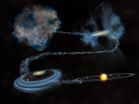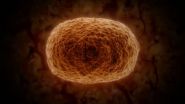(Press-News.org) A study published on September 25th in PLOS Pathogens reports a new primate model to test treatments that might cure HIV/AIDS and suggests answers to questions raised by the "Berlin patient", the only human thought to have been cured so far.
Being HIV-positive and having developed leukemia, the Berlin patient underwent irradiation followed by a bone-marrow transplant from a donor with a mutation that abolishes the function of the CCR5 gene. The gene codes for a protein that facilitates HIV entry into human cells, and the mutation—in homozygous carriers who, like the donor, have two defective copies—protects against HIV infection.
Several factors could have contributed to the cure of HIV/AIDS in the patient: (1) the ablation of blood and immune cells following irradiation killed all or many of the viral reservoir cells that are not eliminated by antiretroviral treatment (ART); (2) the CCR5 deletion mutation in the donor cells protected them and their progeny from HIV infection; (3) a "graft versus host" reaction occurred, where the transplanted cells and their progeny recognize the host cells as foreign and attacked and eliminated HIV-positive reservoir cells that survived the irradiation.
Guido Silvestri, from Emory University in Atlanta, USA, and colleagues investigated the relative contribution of the irradiation to eliminate the reservoir of HIV-infected cells. The scientists worked with the animal model of Simian Immunodeficiency Virus (SIV, a close relative of HIV that infects primates and causes a disease similar to AIDS) infection in rhesus macaques. Using a total of six monkeys (three of which served as controls and did not receive transplants) they performed, for the first time, hematopoietic stem cell transplantation in rhesus macaques infected with a chimeric simian/human immunodeficiency virus (SHIV) and treated with ART.
The researchers harvested hematopoetic stem cells from three macaques prior to infection (of all six animals) with SHIV. They also treated the macaques with ART to reduce viral load and mimic the situation in human HIV-infected patients on ART. They then exposed the three monkeys from which they had collected hematopietic stem cells to a high dose of radiation. This killed most of their existing blood and immune cells, including between 94 and 99% of their CD4-T cells—the main target of HIV infection—in the blood. The irradiation was followed by transplantation of each monkey's own virus-free hematopoietic stem cells. The latter can regenerate the blood and immune cells, and did so in all three monkeys within 3 to 6 weeks. Because the transplanted cells are not from a different donor, no graft versus host disease would be expected, and none was observed.
After that time, the scientists stopped ART in all six monkeys. As expected, the virus rebounded rapidly in the control animals. Of the three transplanted animals, two also showed a rapid rebound. The third monkey developed kidney failure two weeks after ART was stopped and was euthanized. It still had undetectable levels of virus in the blood at that time, but post-mortem analysis showed low levels of viral DNA in a number of tissues, arguing that none of the three transplanted monkeys was cured.
The researchers acknowledge a number of limitations of the study, including the small number of monkeys, and the relatively short period of ART prior to irradiation and transplantation. Nonetheless, they say their study "supports the hypothesis that myeloablative total body irradiation can cause a significant decrease in the viral reservoir in blood cells, even though it was not sufficient to eliminate all reservoirs". Their results, they say, suggest that in the cure of the Berlin patient, "the use of the CCR5 mutant donor and/or the presence of graft versus host disease played a significant role".
Having demonstrated in this first test-of-concept study that total body irradiation and hematopoietic stem cell transplantation in ART-treated SIV-infected rhesus macaques is feasible, the researchers express hope that "further studies using this model will provide critical information for the requirements to cure HIV infection in humans".
INFORMATION:
Please contact plospathogens@plos.org if you would like more information about our content and specific topics of interest.
All works published in PLOS Pathogens are open access, which means that everything is immediately and freely available. Use this URL to provide readers access to the paper:
http://dx.plos.org/10.1371/journal.ppat.1004406 (Link goes live upon article publication)
Contact:
Guido Silvestri
e-mail: gsilves@emory.edu
phone: +1.404.727.9139
Authors and Affiliations:
Maud Mavigner, Emory University, USA
Benjamin Watkins, Children's Healthcare of Atlanta and Emory University School of Medicine, USA
Benton Lawson, Emory University, USA
S. Thera Lee, Emory University, USA
Ann Chahroudi, Emory University, USA; Children's Healthcare of Atlanta and Emory University School of Medicine, USA; Emory University School of Medicine, USA
Leslie Kean; Children's Healthcare of Atlanta and Emory University School of Medicine, USA
Guido Silvestri, Emory University, USA; Emory University School of Medicine, USA
Funding: This work was supported by the Children's Healthcare of Atlanta, Center for Immunology and Vaccines Pilot Award to GS and LK, RR000165/OD011132 to the Yerkes National Primate Research Center, and P30 AI050409 to the Emory Center for AIDS Research. The funders had no role in study design, data collection and analysis, decision to publish, or preparation of the manuscript.
Competing Interests: The authors have declared that no competing interests exist.
Citation: Mavigner M, Watkins B, Lawson B, Lee ST, Chahroudi A, et al. (2014) Persistence of Virus Reservoirs in ART-Treated SHIV-Infected Rhesus Macaques after Autologous Hematopoietic Stem Cell Transplant. PLoS Pathog 10(9): e1004406. doi:10.1371/journal.ppat.1004406
Stem cell transplant does not cure SHIV/AIDS after irradiation of infected rhesus macaques
2014-09-25
ELSE PRESS RELEASES FROM THIS DATE:
Interstellar molecules are branching out
2014-09-25
Scientists from the Max Planck Institute for Radio Astronomy (Bonn, Germany), Cornell University (USA), and the University of Cologne (Germany) have for the first time detected a carbon-bearing molecule with a "branched" structure in interstellar space. The molecule, iso-propyl cyanide (i-C3H7CN), was discovered in a giant gas cloud called Sagittarius B2, a region of ongoing star formation close to the center of our galaxy that is a hot-spot for molecule-hunting astronomers. The branched structure of the carbon atoms within the iso-propyl cyanide molecule is unlike the ...
Stone Age site challenges old archaeological assumptions about human technology
2014-09-25
The analysis of artifacts from a 325,000-year-old site in Armenia shows that human technological innovation occurred intermittently throughout the Old World, rather than spreading from a single point of origin, as previously thought.
The study, published today in the journal Science, examines thousands of stone artifacts retrieved from Nor Geghi 1, a unique site preserved between two lava flows dated to 200,000–400,000 years ago. Layers of floodplain sediments and an ancient soil found between these lava flows contain the archaeological material. The dating of volcanic ...
Earth's water is older than the sun
2014-09-25
Washington, D.C.—Water was crucial to the rise of life on Earth and is also important to evaluating the possibility of life on other planets. Identifying the original source of Earth's water is key to understanding how life-fostering environments come into being and how likely they are to be found elsewhere. New work from a team including Carnegie's Conel Alexander found that much of our Solar System's water likely originated as ices that formed in interstellar space. Their work is published in Science.
Water is found throughout our Solar System. Not just on Earth, but ...
Agonizing rabies deaths can be stopped worldwide
2014-09-25
The deadly rabies virus--aptly shaped like a bullet-- can be eliminated among humans by stopping it point-blank among dogs, according to a team of international researchers led by the Paul G. Allen School for Global Animal Health at Washington State University.
Ridding the world of rabies is cost-effective and achievable through mass dog vaccination programs, the scientists report in a paper that appears in the Sept. 26 issue of Science magazine. What's more, they write, because infections occur as a result of interactions between animals and people, a "One Health" approach ...
Heritage of Earth's water gives rise to hopes of life on other planets
2014-09-25
A pioneering new study has shown that water found on Earth predates the formation of the Sun – raising hopes that life could exist on exoplanets, the planets orbiting other stars in our galaxy.
The ground-breaking research set out to discover the origin of the water that was deposited on the Earth as it formed.
It found that a significant fraction of water found on Earth, and across our solar system, predates the formation of the Sun. By showing that water is 'inherited' from the environment when a star is born, the international team of scientists believe other exoplanetary ...
Harvesting hydrogen fuel from the Sun using Earth-abundant materials
2014-09-25
VIDEO:
Science published on Sept. 25, 2014 the latest developments in Michael Grätzel's laboratory at EPFL in the field of hydrogen production from water. By combining a pair of perovskite solar...
Click here for more information.
The race is on to optimize solar energy's performance. More efficient silicon photovoltaic panels, dye-sensitized solar cells, concentrated cells and thermodynamic solar plants all pursue the same goal: to produce a maximum amount of electrons ...
Innovative Stone Age tools were not African invention, say researchers
2014-09-25
A new discovery of thousands of Stone Age tools has provided a major insight into human innovation 325,000 years ago and how early technological developments spread across the world, according to research published in the journal Science.
Researchers from Royal Holloway, University of London, together with an international team from across the United States and Europe, have found evidence which challenges the belief that a type of technology known as Levallois – where the flakes and blades of stones were used to make useful products such as hunting weapons – was invented ...
New discovery could pave the way for spin-based computing
2014-09-25
PITTSBURGH—Electricity and magnetism rule our digital world. Semiconductors process electrical information, while magnetic materials enable long-term data storage. A University of Pittsburgh research team has discovered a way to fuse these two distinct properties in a single material, paving the way for new ultrahigh density storage and computing architectures.
While phones and laptops rely on electricity to process and temporarily store information, long-term data storage is still largely achieved via magnetism. Discs coated with magnetic material are locally oriented ...
Longstanding bottleneck in crystal structure prediction solved
2014-09-25
Two years after its release, the HIV-1 drug Ritonavir was pulled from the market. Scientists discovered that the drug had crystallized into a slightly different form—called a polymorph—that was less soluble and made it ineffective as a treatment.
The various patterns that atoms of a solid material can adopt, called crystal structures, can have a huge impact on its properties. Being able to accurately predict the most stable crystal structure for a material has been a longstanding challenge for scientists.
"The holy grail of this particular problem is to say, I've written ...
Genetic 'instruction set' for antibodies knocks down hepatitis C in mice
2014-09-25
A triple-punch of antibodies both prevented hepatitis C infection and wiped out the disease after it had established itself in laboratory mice, according to a study led by Princeton University researchers. Instead of delivering the three antibodies directly, the researchers administered a genetic "instruction set" that, once in a cell, developed into antibodies that target the portions of the virus that do not mutate.
Mice treated with the antibody genetic code resisted becoming infected with hepatitis C when they were exposed to the virus, the researchers reported in ...






